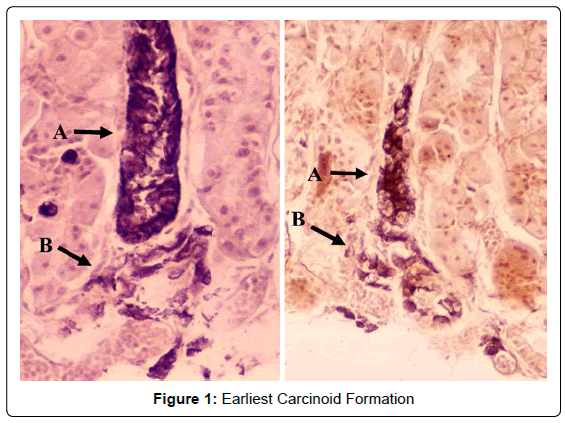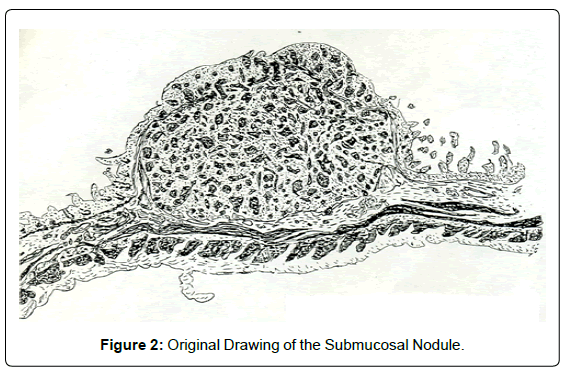Commentary Open Access
Considerations on Some Problems in Carcinoid Research
Jun Soga*
Professor Emeritus, Niigata University, Japan
- *Corresponding Author:
- Jun Soga
Professor Emeritus
Niigata University
Niigata, 950-2074, Japan
Tel: +81-25-266-9230
E-mail: soga-j@ma.tlp.ne.jp
Received date: Jun 10, 2013; Accepted date: September 30, 2013; Published date: October 03, 2013
Citation: Soga J (2013) Considerations on Some Problems in Carcinoid Research. J Gastroint Dig Syst 3:143. doi:10.4172/2161-069X.1000143
Copyright: © 2013 Soga J. This is an open-access article distributed under the terms of the Creative Commons Attribution License, which permits unrestricted use, distribution, and reproduction in any medium, provided the original author and source are credited.
Visit for more related articles at Journal of Gastrointestinal & Digestive System
Abstract
Three points of emphasis unrelated to each other are described. First: Detailed mechanism of the earliest carcinoid formation in the form of a budding phenomenon is clearly demonstrated in a colored photo of consective serial sections of the gastric gland. Second: The original drawing of the submucosal nodule for which the term “carcinoid” was proposed as a benign tumor is pointed out to be a result of malignant invasion of neoplastic cells originating in the mucosa and penetrating the muscularis mucosae. Third: Based on the concept that the term “carcinoid” is a misnomer, an alternative term “endocrinocarcinoma (ECC)” is roposed.
Keywords
Carcinoid, Neuroendocrine Tumor (NET); Neuro endocrine carcinoma (NEC); Endocrinocarcinoma (ECC); Budding phenomenon; Misnomer
Introduction
In this brief article, three topics, unrelated to each other, are emphasized; a mysterious mechanism of the earliest carcinoid formation, reevaluation of original drawing of the submucosal nodule, and a consideration of terminology for this tumor.
Earliest Carcinoid Formation Clearly Demonstrated by a Colored Photo
A colored photo (Figure 1) shows compact distribution of Grimelius- positive cells (G-cells) in a gastric gland derived from an African rodent [1-3].
On the left: the upper portion of the gland is entirely replaced by G-cells but the configuration of the gland is well preserved. The lower portion is distorted with irregularly arranged G-cells apparently invading into the surroundings.
Thus, one gland displays different stages of G-cell proliferation; intraglandular preneoplastic - or frankly neoplastic-cell proliferation (arrow A), and extraglandular (intramucosal) neoplastic-cell proliferation with “budding phenomenon” (arrow B).
As a whole this gland discloses earliest carcinoid formation and its malignancy at its origin.
On the right: one of multiple consecutive serial sections of the same gland apart from the center exhibits somewhat blurred and distorted configuration of the gland in the upper portion but without definite invasion, while obvious invasion to the surroundings is evident in the lower portion.
Original Drawing of the Submucosal Nodule Described as a Benign Carcinoid by Oberndorfer
A detailed drawing of a carcinoid published in 1907 by Oberndorfer [4] is composed mostly of a submucosal nodule, histologically exhibiting a tendency to form a mixture of immature to relatively wellformed tubular structures. This submucosal nodule is well-defined but without any capsular element (Figure 2).
Obviously the nodule is only a by-player, and the leading player is a small lesion in the mucosa. Namely, this neoplasm originates in the mucosa, penetrating the muscularis mucosae, and forms a nodule in the submucosal layer that is larger than the primary site in the mucosa.
Thus, the submucosal nodule represents a malignant nature of this lesion. If Oberndorfer should have recognized this fact, the term “carcinoid” would not have been proposed.
Oberndorfer was a gifted physician and pathologist with a wide variety of interest in all fields of medicine and published a number of reports, among which two are well known to deal with carcinoid; in the first one [4], the term “carcinoid” was proposed as a benign tumor, and, in the second [5], a revision was made on some cases with metastases as cases having a malignant tumor.
It seems that malignancy was evaluated by metastases neglecting invasion as a prestage of vascular permeation that would result in metastases.
Terminology-the term “carcinoid” is a misnomer
Based on the proved malignant nature of carcinoid, it was pointed out that the term “carcinoid” is a misnomer [1,6]. The problem is whether or not there is an acceptable term replacing “carcinoid”. “Neuroendocrine tumor (NET)” [7-9] does not specify the malignancy of the neoplasm.
Then, “Neuroendocrine carcinoma (NEC)” might be better but the necessity of the prefix “neuro-” is not clear.
“Endocrinocarcinoma (ECC)” [1,10] may best represent the true malignant entity of the neoplasm in the present discussion (1), though this term lacks an attractive feeling that has been shown by both “carcinoid” and “NET”
Ending Note
The author expects that three points emphasized above, each indicating a present problem, are to be widely recognized, understood and evaluated for further development of research activities in this particular field.
References
- Soga J (2012) Reevaluation of the term "carcinoid" how to deal with this misnomer. Nihon Rinsho 70: 1427-1435.
- Soga J (2005) Early-stage carcinoids of the gastrointestinal tract: an analysis of 1914 reported cases. Cancer 103: 1587-1595.
- Cockburn AN, Morgan CJ, Genta RM (2013) Neuroendocrine proliferations of the stomach: a pragmatic approach for the perplexed pathologist. Adv Anat Pathol 20: 148-157.
- Oberndorfer S, Frankfrt Z Pathol (1907) Karzinoide Tumoren des Dundarms. CiNii 1: 428-432.
- Oberndorfer S (1929) Die Geschwulste des Darms. In: Handbuch der speziellen pathologischen Anatomie und Histologie. Bd. 4. Teil. Verdauungsschauch (ed by Henke F, Lubarsch O) Springer 3: 717-953.
- Soga J (2009) The term "carcinoid" is a misnomer: the evidence based on local invasion. J Exp Clin Cancer Res 28: 15.
- Klöppel G (2011) Classification and pathology of gastroenteropancreatic neuroendocrine neoplasms. Endocr Relat Cancer 18 Suppl 1: S1-16.
- Rindi G, Klöppel G, Alhman H, Caplin M, Couvelard A, et al. (2006) TNM staging of foregut (neuro)endocrine tumors: a consensus proposal including a grading system. Virchows Arch 449: 395-401.
- Rindi G, Klöppel G, Couvelard A, Komminoth P, Körner M, et al. (2007) TNM staging of midgut and hindgut (neuro) endocrine tumors: a consensus proposal including a grading system. Virchows Arch 451: 757-762.
- Soga J, Ferlito A, Rinaldo A (2004) Endocrinocarcinomas (carcinoids and their variants) of the larynx: a comparative consideration with those of other sites. Oral Oncol 40: 668-672.
Relevant Topics
- Constipation
- Digestive Enzymes
- Endoscopy
- Epigastric Pain
- Gall Bladder
- Gastric Cancer
- Gastrointestinal Bleeding
- Gastrointestinal Hormones
- Gastrointestinal Infections
- Gastrointestinal Inflammation
- Gastrointestinal Pathology
- Gastrointestinal Pharmacology
- Gastrointestinal Radiology
- Gastrointestinal Surgery
- Gastrointestinal Tuberculosis
- GIST Sarcoma
- Intestinal Blockage
- Pancreas
- Salivary Glands
- Stomach Bloating
- Stomach Cramps
- Stomach Disorders
- Stomach Ulcer
Recommended Journals
Article Tools
Article Usage
- Total views: 13880
- [From(publication date):
October-2013 - Dec 08, 2025] - Breakdown by view type
- HTML page views : 9208
- PDF downloads : 4672


